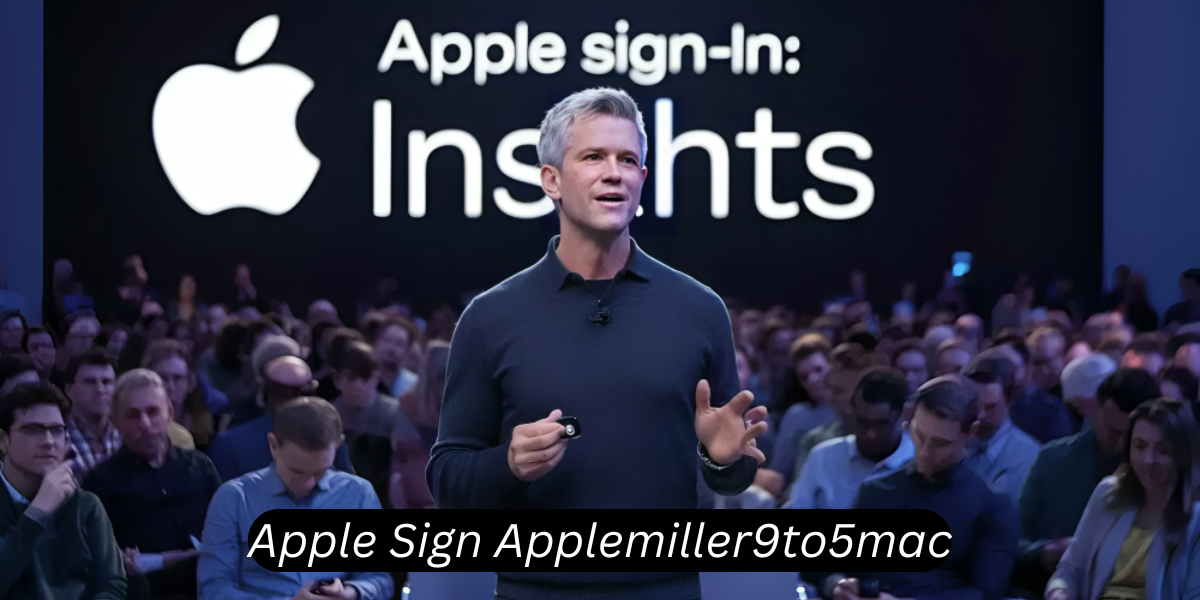
Apple continues to push the boundaries of technology and user experience with its relentless focus on privacy, security, and simplicity. One of the company’s most notable innovations in recent years is apple sign applemiller9to5mac—officially known as “Sign in with Apple”—a secure, private, and convenient way for users to log into apps and websites. Apple Sign is a direct response to the growing demand for privacy-preserving login methods that simplify the user experience while protecting personal data.
In this comprehensive guide, we’ll explore Apple Sign from every angle, diving into its features, comparing it to other login options, discussing how it benefits users and developers, and looking at its role in shaping the future of secure logins. Whether you’re a developer, tech enthusiast, or just someone looking for better security online, this article provides everything you need to know about Apple Sign, all through the lens of apple sign applemiller9to5mac.
What Is Apple Sign? A Secure Gateway for Users
At its core, Apple Sign is a login method that allows users to sign into apps and websites using their Apple ID, rather than creating separate accounts. While there are many login services available today, such as Google and Facebook login, Apple Sign stands apart due to its emphasis on privacy and security.
Key Features of Apple Sign
Apple Sign offers several important features that distinguish it from other login methods:
- Single Sign-On (SSO): By using a single Apple ID, users can access multiple apps and websites without needing to create separate accounts or remember multiple passwords.
- Minimal Data Sharing: When using Apple Sign, users can choose to share as little information as possible with third-party apps, such as hiding their email address.
- Biometric Authentication: Face ID or Touch ID adds an extra layer of security, ensuring that only the authorized user can log in.
- Cross-Platform Support: Although it’s optimized for Apple’s ecosystem, Apple Sign is also available for websites and apps on other platforms.
Understanding How Apple Sign Works
Behind the Scenes: The Technical Flow
When a user chooses to log into an app or website with Apple Sign, here’s what happens in the background:
- Apple ID Authentication: Apple verifies the user’s Apple ID and ensures that they have enabled two-factor authentication, which is a prerequisite for using Apple Sign.
- Data Sharing Options: Users are prompted to either share or hide their email address. If the user chooses to hide their email, Apple generates a unique, randomly assigned email address that acts as a proxy.
- Token-Based Authentication: Apple generates a secure token that is sent to the app or website, confirming that the user has successfully logged in without revealing unnecessary personal data.
This technical flow ensures that Apple Sign offers a seamless login experience while maintaining the highest levels of privacy and security.
Apple’s Privacy-Centric Approach
Apple’s primary differentiator is its privacy-first approach. Unlike other login services, Apple Sign does not track user behavior or collect data to sell to third parties. Here’s how it achieves this:
- Randomized Emails: Instead of sharing your actual email address, Apple generates a random email that forwards to your inbox. This prevents apps from associating your email with your identity or tracking you across platforms.
- No Advertising: Unlike Google or Facebook login services, Apple Sign is not used for ad targeting. Apple has no incentive to track user activity, giving users peace of mind.
Comparing Apple Sign to Other Login Methods
Apple Sign vs. Google Login
Google Login is one of the most popular single sign-on methods available today. Here’s a comparison between Apple Sign and Google Login:
- Data Sharing: Google Login shares more personal information with third-party apps than Apple Sign. While Google uses data for advertising purposes, Apple limits data sharing to protect user privacy.
- Cross-Platform Integration: Both login methods work across different platforms. However, Apple Sign offers deeper integration within Apple’s ecosystem, allowing for features like Face ID and Touch ID.
- Security: Both methods support two-factor authentication, but Apple Sign integrates biometric security more seamlessly through Apple devices.
Apple Sign vs. Facebook Login
Similar to Google Login, Facebook Login has been a widely used method for years. However, recent privacy concerns have made some users wary of sharing their information with Facebook. Here’s how Apple Sign compares:
- Privacy: Facebook Login collects extensive user data, which can be used for ad targeting and other purposes. In contrast, Apple Sign is far more privacy-focused, minimizing the amount of personal data shared.
- User Trust: Apple is generally seen as a more trustworthy company when it comes to privacy. Many users feel more comfortable using Apple Sign over Facebook Login because of Apple’s commitment to data protection.
Apple Sign vs. Traditional Email/Password Login
Traditional logins require users to create a unique account for each service, often leading to password fatigue and weaker security. Apple Sign eliminates these issues by offering:
- Password-Free Login: With Apple Sign, users no longer need to create or remember passwords. Face ID or Touch ID can be used to authenticate the user, making the process faster and more secure.
- Reduced Risk of Account Takeover: Since users don’t need to reuse passwords across different services, Apple Sign minimizes the risk of account takeover from phishing or password leaks.
Why Users Should Choose Apple Sign

1. Privacy and Control
One of the top reasons to use Apple Sign is privacy. Users have more control over what information they share with third-party apps. Additionally, by choosing to hide their email, they can limit the ability of apps to track their activity across platforms.
2. Ease of Use
The simplicity of Apple Sign is another key advantage. Users no longer need to remember dozens of passwords or deal with frustrating account creation processes. A single tap or facial recognition is all it takes to log in.
3. Biometric Security
Apple Sign supports biometric authentication, such as Face ID and Touch ID. This adds an additional layer of security, ensuring that only the authorized user can log in. Even if someone else gets hold of your device, they won’t be able to access your accounts without your face or fingerprint.
4. Avoiding Spam and Unwanted Emails
By using Apple’s Hide My Email feature, users can avoid sharing their real email address with third-party apps. This prevents them from being inundated with marketing emails, improving their overall online experience.
Why Developers Should Integrate Apple Sign
1. Increased User Adoption and Trust
Offering Apple Sign can help developers increase user adoption rates. With growing concerns over privacy, users are more likely to sign up for an app that offers a trusted and secure login option like Apple Sign.
2. Higher Conversion Rates
By reducing friction in the sign-up process, Apple Sign can lead to higher conversion rates. Users are more likely to complete the sign-up process when they don’t need to fill in long forms or create new passwords.
3. Compliance with Apple’s Guidelines
For apps on the App Store, Apple requires developers to offer Apple Sign if other third-party login methods (such as Google or Facebook) are used. This ensures that developers comply with Apple’s privacy guidelines, which helps maintain their app’s reputation.
4. Simplified Integration
Apple provides developers with clear documentation and APIs to integrate Apple Sign easily into their apps. This makes it an attractive option for developers who want to enhance their app’s functionality without investing too much time or effort.
Use Cases for Apple Sign
1. E-Commerce Apps
E-commerce apps can greatly benefit from Apple Sign. By offering a simple, secure login option, these apps can reduce friction during the checkout process. This not only improves the user experience but also helps increase conversion rates.
2. Social Media Apps
For social media apps, Apple Sign provides a secure and privacy-conscious alternative to traditional logins. Users are increasingly concerned about how their data is used by social media platforms, and offering Apple Sign can help build trust.
3. Subscription-Based Services
Subscription-based services can leverage Apple Sign to simplify the account creation and management process. By reducing the need for users to create new accounts, these services can improve retention and reduce churn.
4. Healthcare Apps
With the increasing use of mobile apps for managing healthcare data, privacy and security are of utmost importance. Apple Sign offers a highly secure way for users to log in to healthcare apps without sharing unnecessary personal information.
The Future of Apple Sign
Looking ahead, Apple Sign is poised to play an even greater role in the digital landscape. As privacy concerns continue to dominate the conversation, users will increasingly demand more secure and private login options.
1. Wider Adoption Across Platforms
While Apple Sign is currently optimized for Apple’s ecosystem, we may see it expand to other platforms in the future. As more developers and companies recognize the importance of privacy, Apple Sign could become the default login method for many apps and websites.
2. Enhanced Security Features
Apple is constantly innovating in the realm of security. In the future, we can expect even more advanced security features to be integrated into Apple Sign, further enhancing its position as the most secure login option available.
3. A Shift Toward Passwordless Authentication
As Apple Sign continues to grow in popularity, it could lead to a broader shift toward passwordless authentication across the web. Other companies may follow Apple’s lead and offer more secure, biometric-based login options.
For More information Visit: peace Magazines
Conclusion
Apple Sign represents a significant step forward in the realm of online privacy and security. By offering users a simple, secure, and privacy-conscious way to log into apps and websites, Apple is helping to shape the future of digital identity. For developers, integrating Apple Sign can lead to higher user adoption, improved conversion rates, and compliance with Apple’s privacy guidelines.
As we look to the future, it’s clear that Apple Sign will continue to play a pivotal role in shaping the way we interact with digital platforms. Whether you’re a user or a developer, Apple Sign offers significant benefits that make it a must-have in today’s privacy-conscious world.
FAQs
1. What is Apple Sign?
Answer: Apple Sign, also known as “Sign in with Apple,” is a secure login method that allows users to access apps and websites using their Apple ID. It focuses on privacy, letting users choose what personal information to share with third-party applications.
2. How does Apple Sign protect my privacy?
Answer: Apple Sign enhances privacy by allowing users to hide their email addresses. Instead of sharing their real email, users can opt for a randomly generated email address that forwards messages to their actual inbox, ensuring their identity remains protected.
3. Can I use Apple Sign on non-Apple devices?
Answer: Yes, while Apple Sign is optimized for Apple devices, it can also be used on non-Apple platforms via supported websites and applications. Users can log in using their Apple ID on any compatible browser.
4. Is Apple Sign secure?
Answer: Yes, Apple Sign is highly secure. It employs two-factor authentication and biometric verification methods like Face ID or Touch ID, ensuring that only authorized users can log in. Additionally, Apple does not track users’ activities or sell their data.
5. What happens if I forget my Apple ID password?
Answer: If you forget your Apple ID password, you can reset it through the Apple ID account page or the Settings app on your device. Follow the prompts to verify your identity and create a new password.
6. Do I need an Apple device to use Apple Sign?
Answer: No, you do not need an Apple device to use Apple Sign. While it is designed to integrate seamlessly with Apple products, you can use it on other devices as long as the app or website supports the feature.
7. How do developers implement Apple Sign in their apps?
Answer: Developers can implement Apple Sign by following Apple’s developer documentation. It involves integrating the Sign in with Apple API, allowing users to authenticate using their Apple ID while managing privacy settings.
8. Can I use Apple Sign for every app?
Answer: Not every app supports Apple Sign. However, if an app offers other third-party login options (like Google or Facebook), it must also provide Apple Sign as a login option according to Apple’s App Store guidelines.







